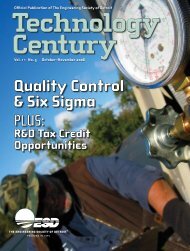Download - ESD
Download - ESD
Download - ESD
- No tags were found...
You also want an ePaper? Increase the reach of your titles
YUMPU automatically turns print PDFs into web optimized ePapers that Google loves.
Communications Commission (FCC) allocated a spectrum in<br />
the “S” bandwidth (2.3 GHz) for nationwide broadcasting of<br />
satellite-based digital audio radio service (DARS). In 1997, the<br />
FCC gave licenses to use part of that spectrum to two companies:<br />
CD Radio (now Sirius Satellite Radio) and American Mobile<br />
Radio (now XM Satellite Radio). The two companies had<br />
similar approaches to their implementation of satellite radio.<br />
XM Satellite Radio uses two Hughes/Alcatel satellites, placed<br />
in parallel geostationary orbits. The satellite digital audio radio’s<br />
(SDAR) signal architecture uses spatial, time and frequency<br />
diversity to improve the reception performance in a mobile<br />
environment. Programming is repeated from three sources: two<br />
satellite paths and one terrestrial path. Sirius Satellite Radio uses<br />
three SS/L-1300 satellites to form an inclined elliptical satellite<br />
constellation (Fig. 5). The elliptical path of the satellite constellation<br />
ensures that each satellite spends about 16 hours a day over<br />
the continental United States.<br />
XM Satellite Radio’s ground station transmits a signal to the<br />
satellites, which bounce the signals back down to radio receivers<br />
on the ground. In urban areas, where buildings can block out<br />
the satellite signal, the broadcast is supplemented by ground<br />
transmitters. The radio receivers are programmed to receive<br />
and unscramble the digital data signal, which contains up to 100<br />
channels of digital audio (local- and non-local-based programs<br />
available with large program-type selections). In addition to the<br />
encoded sound, the signal contains all the metadata for the audio<br />
content such as song title, artist and genre.<br />
The Sirius Satellite Radio receiver includes two parts: the<br />
antenna module and the receiver module. The antenna module<br />
picks up signals from the ground repeaters or the satellite,<br />
amplifies the signal and filters out any interference. The signal<br />
is then passed on to the receiver module. Inside the receiver<br />
module is a chipset consisting of eight chips. The chipset<br />
converts the signals from 2.3 GHz to a lower intermediate<br />
frequency. Sirius Satellite Radio provides high audio quality<br />
with an output of downlink processor signal-to-noise radio of<br />
85 dB. Its frequency response from 100 Hz to 15 kHz is<br />
within +/- 3 dB. The Sirius Satellite Radio also provides over<br />
65 commercial-free channels and dynamic bandwidth allocation<br />
for very high quality music programs.<br />
The XM Satellite Radio receiver system includes the<br />
antenna module and a remote receiver module. A separate<br />
receiver box is used to receive the satellite and terrestrial<br />
signals. The remote receiver box makes the radio capable of<br />
receiving the proprietary satellite signal through a custom<br />
chipset. System mechanization calls for an XM Satellite Radio<br />
receiver that will interface with the radio receiver packaged in<br />
the vehicle’s instrumentation panel by means of a data link.<br />
Satellites provide the primary coverage while the repeaters are<br />
used to fill in areas where the vehicle will be blocked from the<br />
Fig. 2: Twenty-four satellites orbit the earth as part of the GPS (Figure<br />
credit: Peter H. Dana).<br />
Fig 3: The navigation screen on CG’s CAN-based navigation radio.<br />
Fig. 4: A cluster navigation display screen in a Chrysler 300.<br />
www.esd.org | The Engineering Society of Detroit | 31
















